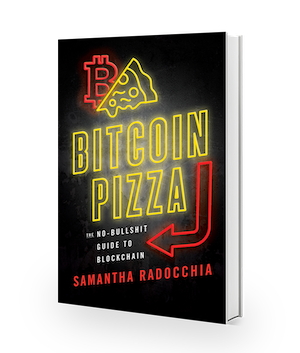The Sexiest Ledger Ever: What is a Blockchain and Why Should I Care?
The following is adapted from Bitcoin Pizza: The No-Bullshit Guide to Blockchain by Samantha Radocchia.
If you’ve been paying attention to developments in the tech world, you’re probably aware of blockchain technology and its most prominent application, bitcoin. The thing is, you may not really understand what blockchain is, how it acts as a foundation for bitcoin, or what else it can do.
Well, I’ve got a few words for you. Blockchain is the sexiest ledger you’ll ever meet and she’s out there kicking ass and taking names. Now, what exactly is blockchain you ask?
Think of this as a primer.
If you’re still unfamiliar with blockchain, you may be wondering why you should care. Blockchain is the technical backbone of Bitcoin and other cryptocurrencies. In the coming digital revolution, blockchain is going to change your life, even if you have no idea what it is. And that’s the problem.
Blockchain is a buzzword. Maybe your kid told you about it last Thanksgiving. Maybe your boss mentioned that it’s the next most important technology for digital transformation and insisted that you attend a few boring-as-hell conferences to learn about it.
But what does it all mean?
When evaluating it for their businesses, people often see it simply as a technology and ask, “Why is this important? Isn’t it just a database?” They’ll really start to see its value and understand its relevance only when they stop thinking in those terms.
The way I see it, blockchain isn’t just a technology. It’s a technological manifestation of a social paradigm shift from centralized to decentralized, from siloed to open, from controlled to self-enforcing. Blockchain isn’t just technology, much less a database, but represents a way of changing how business is done. It opens up silos and makes new ways of working with customers and other businesses possible.
Essentially, blockchain is a distributed ledger technology. That may not sound particularly cool or sexy but writing itself originated with account keeping! Seriously. In ancient Mesopotamia and other cultures, the first writing was a ledger tracking the seasons and planting of crops. Ledgers not only enabled the agrarian revolution, but also laid the groundwork for the advances in communications that made the industrial and digital revolutions possible.
What’s important is not just the technology itself, but what it stands for: a global paradigm shift from data silos and monopolies to interoperability and interconnection. The appearance of blockchain is a unique moment in time, both in our ways of approaching data governance and as a key element in the convergence of new technologies such as big data, machine learning, AI, additive manufacturing, vertical farming, robotics, biotechnology, and the Internet of Things (IoT).
The basis for secure, distributed ledger technology had been around for a while. The concept of blockchain and the term “block chaining” go back to at least 1976, when authors William F. Ehrsam, Carl H. W. Meyer, John L. Smith, and Walter L. Tuchman published a paper called “Message Verification and Transmission Error Detection by Block Chaining.” They also invented cipher block chaining (CBC), where a record from the previous block is inserted into each subsequent block of plain text before being encrypted. Sound familiar?
One analogy, reported by Nick Paumgarten in his article “The Stuff Dreams Are Made Of,” which appeared in the October 22, 2018, issue of The New Yorker, has compared the effects of blockchain to an imaginary clerk in nineteenth-century London making an entry in a ledger that would simultaneously appear in a ledger in Calcutta, the capital of British colonial India. That entry, once made, would be unalterable in either location. What would have been magic in the nineteenth century, the web has now made not only viable but commonplace.
Ledgers Kick Ass: Here’s Why
I give a lot of talks to people who want to understand the blockchain, but don’t really know where to start. Listeners sometimes perk up when I call blockchain “really badass accounting software” because people think that anything “badass” must be interesting. But this description doesn’t really explain much in itself. Calling blockchain a “distributed ledger” is more accurate and conveys a lot more information, but the description isn’t very sexy or compelling.
Recall, however, that writing itself was first developed to keep accounts, and then consider how writing changed the course of human history. Remember that even people who find ledgers and accounting completely boring are usually interested in how much money they have in their bank accounts.
Ledgers are everywhere. I walk through a room in my apartment where the lights are on. If I thought about it for a moment, I’d recall they are being lit by electrical energy. If I had magic glasses on, I’d be able to see the ledger behind the lights. The electric company is recording how much energy is being used and what they are charging for it. With my magic glasses, I could look at every appliance in my kitchen the same way.
There are also records, written or unwritten, of every article of clothing in my closet, every piece of furniture I use, everything I’ve bought and sold, and everything I own. Every time I go to the grocery store and look at the grocery list, that’s a ledger. When I bump into a lady as I walk out of the store, and we both briefly size each other up to make sure neither party is angry, our system of checks, credits, debits, inputs, and outputs is also a ledger.
A good friend who is an artist and ran her own gallery found that bookkeeping was the most interesting part of the job and decided to go into accounting. That’s pretty unusual, but the fact is that there’s accounting in every part of our lives. An artist in a gallery needs to keep track of not just the money that flows in and out but the paintings hanging on the walls or sitting in the backroom, as well as any other registered assets. “Accounting” and “ledgers” are just the way our brains work.
What makes a blockchain a special, innovative ledger is that it is distributed and cannot be changed. I suppose I could put my shopping list into a blockchain, but there would be no reason to do so. Nobody else needs to know what I’m going to get at the market (except in the unlikely case that being at the market at a certain time might supply an alibi that I wasn’t somewhere else committing a murder or other crime).
When a transaction is entered into a blockchain ledger, after being checked for accuracy, it is automatically written on every copy of the ledger — the blockchain — that exists everywhere in the world, whether it be New York, Peoria, Seoul, or Nairobi. Once it is written, it cannot be altered. It becomes what’s called an “immutable record.”
A blockchain stores the data involved in every transaction or “block” of which it is made. However, while blockchains are often compared to databases, which are essentially structured, digital, data-storage containers, the differences between a blockchain and a database are as important as the similarities. A blockchain is a network that shares or distributes data or proof of data. Just as importantly, the data stored in a blockchain must be validated and made impossible to tamper with before it can be, or is, shared. It is an immutable ledger or list of transactions, something that is not true of normal databases.
Applications of a Distributed Ledger
What can this technology do? What are the potential applications of distributed ledger technology? In short, it has the potential to alter almost every aspect of our lives, by validating and storing information in a form that cannot be altered or tampered with.
Blockchain can be thought of both as a distributed ledger and a peer-to-peer system that allows community members to communicate and transact among themselves, without intermediaries or a central authority’s oversight, permission, or interference. Bitcoin is the most well-known application of the blockchain, and it has already demonstrated the potential of decentralized currency.
The potential, however, is almost unlimited. In any sphere of human life where we currently rely on what we’re told by governments, businesses, and other institutions, blockchain technology can provide us with accurate, real-time information. In time, we may come to consider the blockchain as revolutionary as the invention of writing.
Hungry for more? For more insights on how emerging technologies like blockchain will impact your business and daily life, be sure to check out Samantha Radocchia’s #1 Best Selling book — Bitcoin Pizza: The No-Bullshit Guide to Blockchain
Samantha Radocchia is an early blockchain pioneer and advocate who combines the mindsets of an anthropologist and a technologist. She’s led corporate trainings at Fortune 100 companies, governments, and the United Nations, educating leaders on the technologies and cultural shifts that will shape their organizations — and daily lives — in the decades to come. Sam is a contributor to Forbes and was named to their 30 Under 30 List in 2017. A three-time entrepreneur, Sam holds several patents and is a cofounder of Chronicled, an enterprise blockchain company focused on supply chain. She now consults executives on emerging technologies and delivers keynotes at events worldwide as she works to build her next company.


